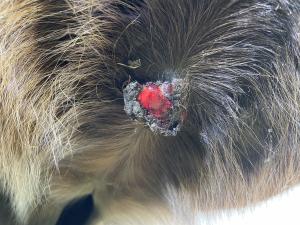
by vet Hannah Marrow
Sarcoids are the most common skin cancer in horses. Although they are a form of cancer, they do not spread to other organs within the body.
Sarcoids can begin as small, rounded lumps but can transform with time to larger, ulcerated, bleeding masses. The development of sarcoids is associated with the presence of Bovine Papilloma Virus, a virus which can be transmitted by flies. It appears that the presence of the virus alone may not be sufficient to lead to sarcoid development; a genetic predisposition is likely also required. Unfortunately, horses with a sarcoid often go on to develop multiple sarcoids during their lifetime.

Bovine Papilloma Virus is implicated in sarcoid development and is present within the sarcoid cells. Flies which feed around the sarcoid can transmit sarcoid cells to other sites on the same horse, or to predisposed horses in the surrounding area, with wounds being a common site for sarcoid development.
Sarcoids forming within a wound is a common cause for a non-healing wound, often presenting in a similar manner to ‘proud flesh’. For this reason, the prompt treatment of sarcoids is important to reduce the likelihood of more sarcoids developing.
As flies are able to spread sarcoid cells around your horse, controlling flies is critical to reducing the likelihood of sarcoids forming. Fly repellent sprays can be applied to the horse. Some creams have also been reported to have fly repellent action. Fly rugs and masks can be used to prevent the flies landing and feeding on the horse. Pastures without standing, stagnant water or excessive tree cover are ideal as they reduce the habitat available for flies.
It is important to remember that sarcoids are a form of cancer and should be treated with respect. Applying anything on sarcoids without seeking expert advice could be very dangerous and detrimental for the horse, potentially decreasing the success of any future treatment.